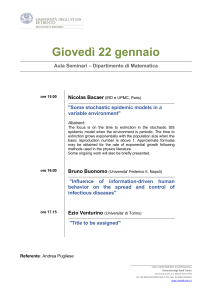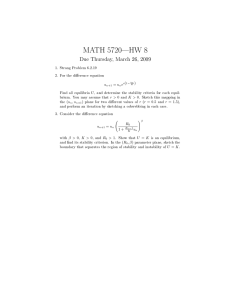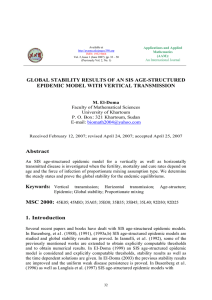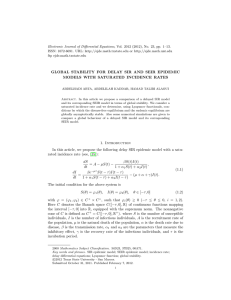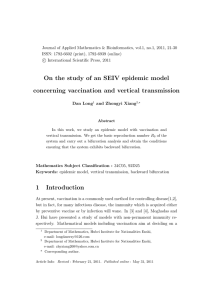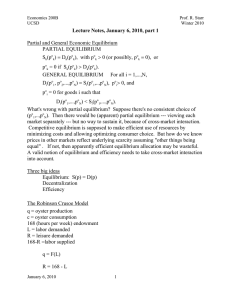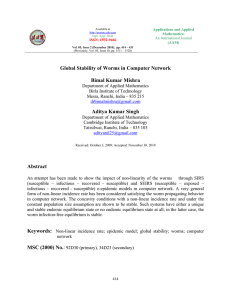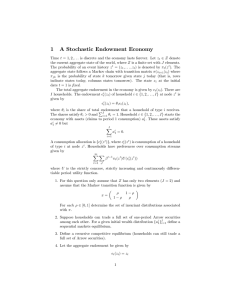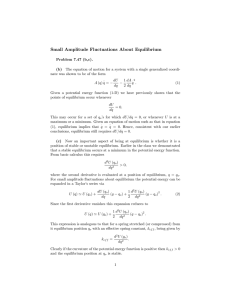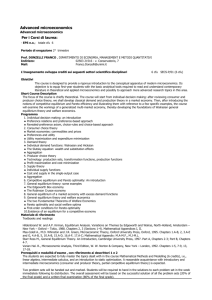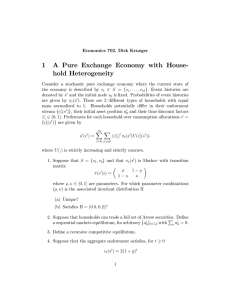Stability of an Age-structured SEIR Epidemic Model with
advertisement
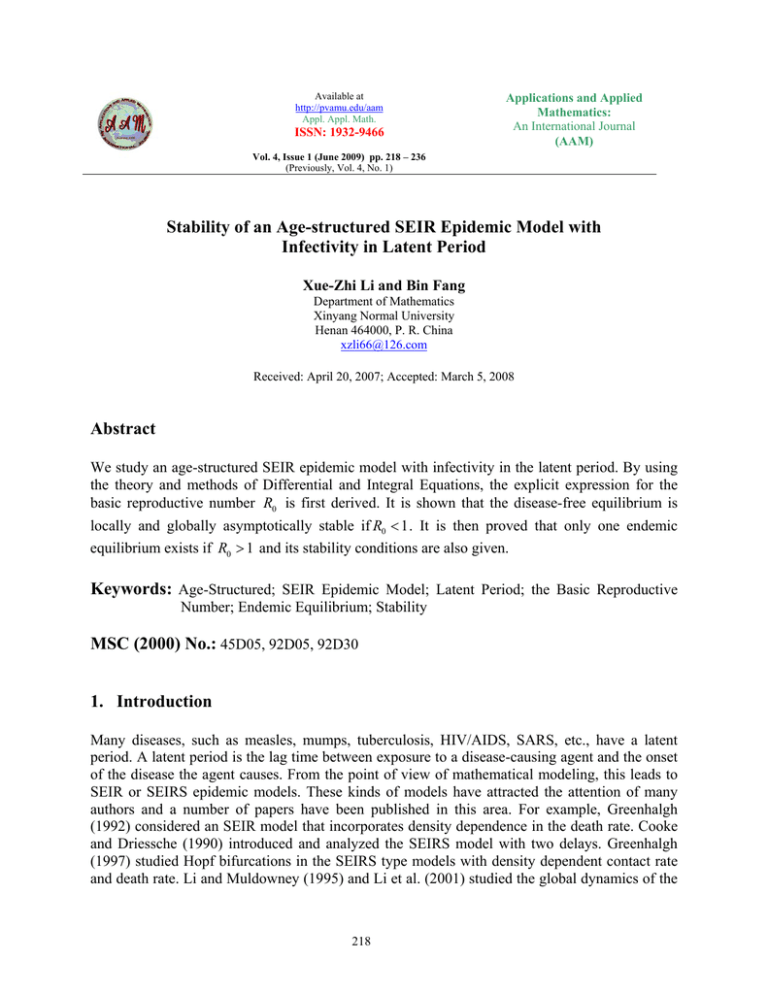
Available at
http://pvamu.edu/aam
Appl. Appl. Math.
ISSN: 1932-9466
Applications and Applied
Mathematics:
An International Journal
(AAM)
Vol. 4, Issue 1 (June 2009) pp. 218 – 236
(Previously, Vol. 4, No. 1)
Stability of an Age-structured SEIR Epidemic Model with
Infectivity in Latent Period
Xue-Zhi Li and Bin Fang
Department of Mathematics
Xinyang Normal University
Henan 464000, P. R. China
xzli66@126.com
Received: April 20, 2007; Accepted: March 5, 2008
Abstract
We study an age-structured SEIR epidemic model with infectivity in the latent period. By using
the theory and methods of Differential and Integral Equations, the explicit expression for the
basic reproductive number R0 is first derived. It is shown that the disease-free equilibrium is
locally and globally asymptotically stable if R0 1 . It is then proved that only one endemic
equilibrium exists if R0 1 and its stability conditions are also given.
Keywords: Age-Structured; SEIR Epidemic Model; Latent Period; the Basic Reproductive
Number; Endemic Equilibrium; Stability
MSC (2000) No.: 45D05, 92D05, 92D30
1. Introduction
Many diseases, such as measles, mumps, tuberculosis, HIV/AIDS, SARS, etc., have a latent
period. A latent period is the lag time between exposure to a disease-causing agent and the onset
of the disease the agent causes. From the point of view of mathematical modeling, this leads to
SEIR or SEIRS epidemic models. These kinds of models have attracted the attention of many
authors and a number of papers have been published in this area. For example, Greenhalgh
(1992) considered an SEIR model that incorporates density dependence in the death rate. Cooke
and Driessche (1990) introduced and analyzed the SEIRS model with two delays. Greenhalgh
(1997) studied Hopf bifurcations in the SEIRS type models with density dependent contact rate
and death rate. Li and Muldowney (1995) and Li et al. (2001) studied the global dynamics of the
218
AAM: Intern. J., Vol. 4, Issue 1 (June 2009) [Previously, Vol. 4, No. 1]
219
SEIR models with a non-linear incidence rate as well as standard incidence rate. Li et al. (1999)
analyzed the global dynamics of the SEIR model with vertical transmission and a bilinear
incidence. Recently, Zhang and Ma (2003) analyzed the global dynamics of the SEIR model with
saturating contact rate. All the models discussed above are of SEIR-type age-independent
epidemic models, which are described by a system of ordinary differential equations. The
importance of age structure in epidemic models has been stressed by many researchers. One may
refer Busenberg (1991), Iannelli (1992, 1998), Inaba (1990), Castillo-Chavez (1989, 1998), Li
(2004), etc., for the discussions concerning age-structured SIR or SIRS models, and Xue-Zhi Li
(2001, 2003), etc. for discussion on age-structured SEIR or SEIRS model. We may note that all
the SEIR or SEIRS models mentioned above assume that the latent individuals have no
infectivity, so, a susceptible individual may become infectious only through contact with
infective.
In fact, many diseases, such as tuberculosis, HIV/AIDS and SARS, etc., have a contagious latent
period, a latent individual can transmit the disease to the susceptible, i.e., the individual has force
of infection in both the latent and infectious periods. This fact has been noticed by some
researchers and the mathematical modeling (ODE cases) and discussions have also been given,
for instance, Li and Jin (2004, 2005, 2006). Whereas in this paper, we establish and study an agestructured SEIR epidemic model with infectivity in both the latent and infectious periods. By
using the theory and methods of Differential and Integral Equations, we first obtain the explicit
expression for the basic reproduction number R0 under the assumption that the total population
size is at stationary demographic state. Then, it is shown that the disease-free equilibrium is
locally and globally asymptotically stable if R0 1 . In this case, the disease always dies out.
When R0 1 , there exists unique endemic equilibrium which is asymptotically stable under
certain conditions.
This paper is organized as follows: in the following section, an age-structured SEIR epidemic
model with infectivity in both the infected and latent periods is introduced. The expression of
reproduction number R0 is obtained in Section 3. The local and global stabilities of the diseasefree equilibrium are also studied in this section. Section 4 discusses the existence and the
stability of the unique endemic equilibrium.
2. The Model
In order to formulate an age-structured SEIR epidemic model with infectivity in latent period, we
need to introduce some notations. The whole population under consideration is divided into
susceptible, latent, infectious and immune (or recovered) classes, where S (a t ) E (a t )
I (a t ) R (a t ) denote the associated density functions with these respective epidemiological agestructured classes.
Let b(a) and (a ) be the vital parameters (age-specific fertility and mortality) of the
population, which we assume not to be affected by the disease, ( (a)) 1 and ( (a )) 1 be the
average latent period and the average infectious period, respectively. We assume that (a ) and
(a) are positive and continuous. For convenience in mathematical calculations in the following
220
Li and Fang
sections, we assume that the infectivity of a latent individual is same as of infectivity of
infectious individual. We adopt the following separable inter-cohort constitutive form for the
force of infection [Castillo-Chavez and Feng (1998)]:
ˆ (a t ) k (a) (t )
a
(t ) (a)
0
E (a t ) I (a t )
da
N (a t )
Here, a is the maximum age that an individual of the population can attain. The age-specific
infectiousness (a) and the age-specific contagion rate k (a ) satisfy the following conditions:
() k () C[0 a ) and (a) k (a ) 0 on [0 a )
We assume that all newborns are susceptible and that an individual may become latent through
contact with latent or infectious individuals, recovered individual has permanent immunity to the
disease. Here we observe that the disease-induced death rate can be neglected. The dynamics of
the age-structured epidemiological classes are governed by the following initial and boundary
value problem:
S (a t ) S (a t )
( (a) ˆ (a t )) S (a t )
t
a
E (a t ) E (a t )
( (a) (a )) E (a t ) ˆ (a t ) S (a t )
t
a
I (a t ) I (a t )
( (a ) (a)) I (a t ) (a) E (a t )
t
a
R(a t ) R(a t )
(a) R(a t ) (a) I (a t )
t
a
ˆ (a t ) k (a) (t )
a
E (a t ) I (a t )
(t ) (a)
da
0
N (a t )
(2.1a)
(2.1b)
(2.1c)
(2.1d)
(2.1e)
(2.1f)
a
S (0 t ) b(a )[ S (a t ) E ( a t ) I (a t ) R( a t )]da
0
E (0 t ) I (0 t ) R(0 t ) 0
S (a 0) S0 (a ) E (a 0) E0 (a)
I (a 0) I 0 (a ) R (a 0) R0 (a)
(2.1g)
(2.1f)
Summing the equations in (2.1), we obtain the following equation for the total population
density N (a t ) S (a t ) E (a t ) I (a t ) R(a t ) :
N (a t ) N (a t )
(a) N (a t )
t
a
(2.2a)
AAM: Intern. J., Vol. 4, Issue 1 (June 2009) [Previously, Vol. 4, No. 1]
a
221
N (0 t ) b(a ) N (a t )da
(2.2b)
N (a 0) N 0 (a)
(2.2c)
0
This is the standard Mckendrik-Von Forester equation. Here, we see that indeed the population
dynamics is not affected by the disease. We make the following hypotheses for this problem
b(a) L ([0 a )) b(a) 0 in [0 a )
(a ) L1loc [0 a ) (a ) 0 in [0 a )
a
0
(a)da
Furthermore, in order to deal with a steady state problem with age density given by (2.2), we
assume that the net reproduction rate of the population is equal to unity and that the total
population is at the steady state. This means that
a
0
a
( ) d
b(a)e 0
da 1
(2.3)
a
( ) d
N (a t ) N (a) b0 e 0
(2.4)
The condition (2.4) is valid because of (2.3). This condition also implies that, in order to deal
with a significant model, we need to take initial data as follows:
S0 (a) 0 E0 (a) 0 I 0 (a ) 0 R0 (a ) 0
(2.5)
S0 (a) E0 (a) I 0 (a) R0 (a) N (a)
which forces the relation
b0
a
0
[ S0 (a) E0 (a ) I 0 (a) R0 (a)]da
a
0
a
( ) d
e 0
da
(2.6)
Now, introducing the fractions
s (a t )
S (a t )
E (a t )
I (a t )
R (a t )
e(a t )
i (a t )
r (a t )
N (a)
N (a)
N (a )
N (a )
we get the following simplified system of equation (2.1):
s (a t ) s (a t )
k (a ) (t ) s (a t )
t
a
(2.7a)
222
Li and Fang
e(a t ) e(a t )
(a )e(a t ) k (a) (a) s (a t )
t
a
i (a t ) i (a t )
(a )i (a t ) (a )e(a t )
t
a
r (a t ) r (a t )
(a )i (a t )
t
a
a
(t ) (a)[e(a t ) i (a t )]da
0
s (0 t ) 1 e(0 t ) i (0 t ) r (0 t ) 0
s (a 0) s0 (a ) e(a 0) e0 (a ) i (a 0) i0 (a) r (a 0) r0 (a)
s (a t ) e(a t ) i (a t ) r (a t ) 1
(2.7b)
(2.7c)
(2.7d)
(2.7e)
(2.7f)
(2.7g)
(2.7h)
In the next section, we derive the explicit expression for R0 , a quantity that must exceed one for
the disease to remain endemic (persist). In general, R0 is called the net reproductive number,
which measures the expected number of secondary infection produced by a ‘typical’ infected
individual during its entire-death adjusted-period of infectious in a wholly susceptible
population.
3. Calculation of R0 and Stability of the Disease-Free Equilibrium
An equilibrium solution is a solution of the system (2.7) when the population state remains
unchanged with time, i.e., a time-independent solution. The disease-free state is the population
state when there are no infectious or latent individuals. A steady state solution
( s(a ) e(a) i (a) r (a)) of the system (2.7) must satisfy
ds (a)
k (a)s (a)
da
de(a )
(a)e(a) k (a)s (a)
da
di (a )
(a)i (a) (a)e(a)
da
dr (a)
(a)i (a)
da
a
(a )[e(a ) i (a )]da
0
s (0) 1 e(0) i (0) r (0) 0
s (0) e(0) i (0) r (0) 1
(3.1a)
(3.1b)
(3.1c)
(3.1d)
(3.1e)
(3.1f)
(3.1g)
It is easy to see that the system (3.1) always has the disease-free equilibrium, which is given by
s 0 (a) 1 e0 (a) i 0 (a) r 0 (a ) 0
(3.2)
AAM: Intern. J., Vol. 4, Issue 1 (June 2009) [Previously, Vol. 4, No. 1]
223
To study the local stability of the disease-free equilibrium, we linearize the system (2.7) about
(3.2). Let s (a t ) e (a t ) i (a t ) r (a t ) be the perturbation in s 0 (a ) e0 (a ) i 0 (a) r 0 (a) , respectively,
i.e.,
s (a t ) s (a t ) s 0 (a) e(a t ) e (a t ) e0 (a)
i (a t ) i (a t ) i 0 (a) r (a t ) r (a t ) r 0 (a)
These perturbations satisfy the following system of equations:
s (a t ) s (a t )
k (a) (t ) s 0 (a)
t
a
e (a t ) e (a t )
(a )e (a t ) k (a) (t ) s 0 (a)
t
a
i ( a t ) i ( a t )
(a ) i (a t ) (a )e (a t )
t
a
r (a t ) r (a t )
(a) i (a t )
t
a
a
(3.3a)
(3.3b)
(3.3c)
(3.3d)
(t ) (a )[e (a t ) i (a t )]da
(3.3e)
s (0 t ) e (0 t ) i (0 t ) r (0 t ) 0
(3.3f)
0
We now consider exponential solutions of the system (3.3) of the form
s (a t ) s (a)et
i (a t ) i (a)et
e (a t ) e (a)et
r (a t ) r (a)et
The functions s (a ) e (a ) i (a ) r (a ) and the parameter satisfy the following system of
equations:
ds (a)
s (a) k (a)
da
de (a )
e (a) (a)e (a) k (a )
da
di (a )
i (a ) (a ) i (a) (a )e (a)
da
dr (a)
r (a ) (a) i (a)
da
a
(3.4a)
(3.4b)
(3.4c)
(3.4d)
(a )[e (a ) i (a)]da
(3.4e)
s (0) e (0) i (0) r (0) 0
(3.4f)
0
224
Li and Fang
Solving (3.4b) and (3.4c) we obtain
e (a)
a
0
a
( ) d ( a )
k ( )e
e
d
a
a
i (a) ( )e ( )e
( ) d ( a )
e
0
(3.5)
d
(3.6)
Substituting (3.5) into (3.6) and changing the order of integration we get
a
0
0
a
( a )
i (a) ( ) k ( )e
e
e
( ) d
e
( a )
( ) d
k ( ) ( )e
e
a
a
d e
a
( ) d
( ) d
( a )
k ( ) ( )e
a
( ) d
e
0
d
d d
0
a
(3.7)
a
( ) d
d d
Substituting (3.5) and (3.7) into (3.4e) it follows that
a
a
a
(a) e ( a ) k ( )[e
0
( ) d
a
( )e
( ) d
e
0
a
( ) d
d ]d da
(3.8)
By dividing both sides by (since 0 ) in (3.8) we get the following characteristic equation
a
a
0
0
1 (a ) e
( a )
a
k ( )[e
( ) d
a
( )e
( ) d
e
a
( ) d
d ]d da
(3.9)
Let us denote the expression in the right hand side of (3.9) by F ( ) and define the basic
reproductive number as R0 F (0) , i.e.,
a
a
0
0
R0 (a )
a
a
( ) d
k ( )[e
( )e
( ) d
e
a
( ) d
d ]d da
(3.10)
Now, we establish the following result.
Theorem 3.1.
The disease-free equilibrium of the system (2.7) is locally asymptotically stable if R0 1 and
unstable if R0 1 .
Proof:
We observe that
AAM: Intern. J., Vol. 4, Issue 1 (June 2009) [Previously, Vol. 4, No. 1]
F ( ) 0
lim F ( ) 0
225
lim F ( )
We know that equation (3.9) has a unique negative real solution , if and only if F (0) 1 ,
or R0 1 . Also, equation (3.9) has a unique positive (zero) real solution if F (0) 1 ( F (0) 1 ), or
R0 1 ( R0 1 ). To show that is the dominant real parts of roots of F ( ) , we let
x iy ( x y IR , where i is the imaginary unit and IR is the set of real numbers) be an
arbitrary complex solution of the equation (3.9). We note that
1 F ( ) F ( x yi) F ( x) ,
which indicates that Re , where Re denotes the real part. It follows that the disease-free
equilibrium is locally asymptotically stable if R0 1 , and unstable if R0 1 . This completes the
proof.
The basic reproduction number R0 can be seen as a weighted value of the basic reproduction
number due to latent class and the basic reproduction number due to infectious class.
When R0 1 , the number of infections decreases towards zero. The basic reproductive number R0
must exceed one for the disease to persist in the population.
The global stability of the disease-free equilibrium is demonstrated in the following theorem.
Theorem 3.2.
The disease-free equilibrium of the system (2.7) is globally asymptotically stable if R0 1 .
Proof:
To prove the global stability of the disease-free equilibrium, we have to show that
s (a t ) 1 e(a t ) 0 i (a t ) 0 r (a t ) 0 as t . Integrating equation (2.7b) and equation
(2.7c) along the characteristic line we get the following:
( ) d
a
s
s ( s t a s )ds
a t
0 k ( s ) (t a s )e
e ( a t )
t
e (a t )e 0 ( a ) d t k (a ) (t )e 0 ( a ) d s (a t )d a t
0
0
(3.11)
( ) d
a
d
a t
0 ( )e( t a )e
i ( a t )
t
i (a t )e 0 ( a ) d t (a )e(a t )e 0 ( a ) d d a t
0
0
(3.12)
a
a
For t a , by substituting (3.11) into (3.12) and changing the order of integration we obtain
226
Li and Fang
a
0
0
i (a t ) ( )[
a
a
( ) d
k ( s) (t a s)e s
s( s t a s )ds ]e
a
( ) d
k ( s ) (t a s ) s ( s t a s ) ( )e s
e
a
( ) d
( ) d
s
0
d
(3.13)
d ds
Putting the values of e(a t ) and i (a t ) from the equations (3.11) and (3.13) respectively in the
expression for (t ) in equation (3.4e), we obtain
t
a
(t ) (a)[e(a t ) i (a t )]da (a)[e(a t ) i(a t )]da
(3.14)
t
0
t
a
0
0
(a ){ k ( s ) (t a s ) s ( s t a s )
a
a
a
( ) d
( ) d
[e s
( )e s
e
( ) d
s
a
d ]ds}da (a )[e(a t ) i (a t )]da
t
Since e(a t ) and i (a t ) do not exceed one, and same is true for their sum, the last integral can be
estimated by
t
a
(a)da which decreases to zero as t . It is noted that s (a t ) 1 , so
a
a
a
( ) d
( ) d
(t ) (a){ k ( s) (t a s) [e s
e
( )e s
t
a
0
0
( ) d
s
a
d ]ds}da (a)da
t
Taking the limit supremum when t on the both sides of the above equation and using
Fatou’s Lemma we get
lim (t ) R0 lim sup (t )
t
t
(3.15)
As we assume that R0 1 , the only way inequality (3.15) can hold is if
lim sup (t ) 0
t
Using this result in (3.11) and (3.12) we see that
lim sup e(a t ) 0 lim sup i (a t ) 0
t
t
pointwise in a . Furthermore, from equation (2.7a), equation (2.7d) and the fact that
s (a t ) e(a t ) i (a t ) , and r (a t ) add up to one, it is clear that
lim sup s (a t ) 1 lim sup r (a t ) 0
t
t
AAM: Intern. J., Vol. 4, Issue 1 (June 2009) [Previously, Vol. 4, No. 1]
227
Therefore, the disease-free equilibrium is globally asymptotically stable if R0 1 . This completes
the proof of Theorem 3.2.
The global stability of the disease-free equilibrium implies that, given a set of parameters
satisfying R0 1 , for any initial positive number of infectious individuals, the number of latent
infectious individuals and the normal infectious individuals decrease to zero. Such prediction can
be of important use in planning and evaluation of disease control policy.
In the next section, we consider the existence and stability of the unique endemic equilibrium
when R0 1 .
4. The Existence and Local Stability of the Endemic Equilibrium
In Section 3, we showed that the disease-free equilibrium is unstable if R0 1 . In fact, a
nontrivial steady state appears at the same time, which is discussed in the following theorem.
Theorem 4.1.
There exists an endemic equilibrium of the system (2.7) if R0 1 .
Proof:
The method commonly used to find an endemic steady state for age-structured models consists
of obtaining expressions for a time independent solution ( s ( a) e ( a) i ( a) r ( a)) of the system
(2.7) that satisfies
ds (a)
k (a) s (a)
da
de (a )
(a )e (a ) k (a ) s (a )
da
di (a )
(a)i (a) (a )e (a)
da
dr (a )
(a )i (a )
da
a
(4.1a)
(4.1b)
(4.1c)
(4.1d)
(a)[e (a) i (a)]da
(4.1e)
s (0) 1 e (0) i (0) r (0) 0
s ( a ) e ( a ) i ( a ) r ( a ) 1
(4.1f)
(4.1g)
0
Solving (4.1a), (4.1b) and (4.1c) we get the following:
228
Li and Fang
s (a) e
a
0 k ( ) d
(4.2)
a
a
e (a) k ( ) s ( )e
( ) d
0
i (a )
a
0
a
( )e ( )e
( ) d
d
(4.3)
d
(4.4)
Substituting the value of s (a ) from (4.2) into (4.3) we get
e (a)
a
0
k ( )e
a
0 k ( ) d e ( ) d d
(4.5)
Again substituting the value of e ( a) from (4.5) into (4.4) and changing the order of integration
we get
a
i (a ) ( )
0
0
k ( s )e
a
a
k ( s )e
s
0 k ( ) d
0
k ( )e
a
0 k ( ) d
( )e
s
s
0
s
a
0 k ( ) d e s ( ) d dse
a
a
e
( ) d
s
( ) d
( ) d
d
d ds
a
( ) d ( ) d
( s)e
e s
dsd
(4.6)
Finally, substituting the values of e (a ) and i (a) from the equations (4.5) and (4.6),
respectively, into (4.1e), we get
a
a
(a) k ( )e
0
0
0
k ( ) d
a
s
a
a
( ) d
( ) d ( ) d
[e
e s
ds]d da
( s)e
By dividing both sides of the above equation by (since 0 ), we obtain
a
a
0
0
1 (a ) k ( )e
a
s
a
0 k ( ) d [e ( ) d a ( s)e ( ) d e s ( ) d ds]d da
(4.7)
Let us denote the expression in the right-hand side of (4.8) by G ( ) , then, G ( ) is a continuous
and monotone decrease function of . It is easy to see that the system (2.7) has an endemic
equilibrium expressed by equation (4.2), (4.3) and (4.4) provided the equation (4.7) has a
positive solution . From (3.10) it follows that G (0) R0 . Hence, if R0 1 , then G (0) 1 . From
(4.5), (4.6) and e (a) i (a) 1 , it follows that
a
k ( )e
0
0
k ( ) d
a
s
a
a
( ) d
( ) d
( ) d
[e
ds ]d 1
( s)e
e s
Thus, for any 0 , from (4.7) and (4.8) we can write
(4.8)
AAM: Intern. J., Vol. 4, Issue 1 (June 2009) [Previously, Vol. 4, No. 1]
G ( ) ( a )
a
0
a
[e
a
0
( ) d
k ( )e
a
229
0 k ( ) d
s
a
a
( ) d ( ) d
e s
ds]d da& (a)da
( s)e
0
a
Let (a )da . In particular, for , we have G ( ) 1 , but G (0) 1 . Since G ( ) is
0
a continuous and monotone decrease function of , we conclude that G ( ) 1 has a unique
positive solution in (0 ) . Noting the fact that , the system (2.7) has a unique endemic
equilibrium which is given by the unique solution of the system (4.1) corresponding to
provided R0 1 . This completes the proof.
We note that the above theorem establishes the existence of the endemic equilibrium. In the
following, we try to show the local stability of this endemic equilibrium.
Let sˆ(a, t ), eˆ(a, t ), iˆ(a, t ), rˆ(a, t ) and ˆ (t ) be the perturbations in s (a t ) , e(a t ) , i (a t ) , r (a t )
and (t ) , respectively, i.e.,
ˆ a t ) s (a) e(a t ) eˆ(a t ) e (a )
s (a t ) s(
i (a t ) iˆ(a t ) i ( a) r ( a t ) rˆ(a t ) r (a )
(t ) ˆ (t )
(4.9)
These perturbations satisfy the following system of equations:
sˆ(a t ) sˆ(a t )
k (a ) sˆ(a t ) ˆ (t )k (a ) s (a)
t
a
eˆ(a t ) eˆ(a t )
(a)eˆ(a t ) k (a ) sˆ(a t ) ˆ (t )k (a) s (a)
t
a
iˆ(a t ) iˆ(a t )
(a)iˆ(a t ) (a)eˆ(a t )
t
a
rˆ(a t ) rˆ(a t )
(a)iˆ(a t )
t
a
a
ˆ (t )
(a)[eˆ(a t ) iˆ(a t )]da
0
a
(a)[e (a) i (a )]da
0
We look for the following exponential solutions of the perturbed system (4.10)
sˆ(a t ) s (a )et eˆ(a t ) e (a)et iˆ(a t ) i (a)et rˆ(a t ) r (a )et , and ˆ (t ) et .
(4.10a)
(4.10b)
(4.10c)
(4.10d)
(4.10e)
(4.10f)
230
Li and Fang
The functions s (a ) e (a ) i (a ) r (a ) and the parameter satisfy the following system of
equations:
ds (a)
s (a) k (a) s (a) k (a) s (a)
da
de (a)
e (a) (a )e (a) k (a) s ( a) k ( a) s (a)
da
di (a )
i (a ) (a )i (a ) (a )e (a )
da
dr (a )
r (a) (a)i (a)
da
a
(a)[e (a) i (a)]da
0
a
0
(a)[e (a) i (a)]da
(4.11a)
(4.11b)
(4.11c)
(5.3d)
(4.11e)
(4.11f)
s (0) e (0) i (0) r (0) 0
(4.11g)
We note that the functions s (a ) e (a ) i (a ) r (a ) can take both positive and negative values.
Assuming 0 we set
s (a)
s (a )
e (a )
i (a )
r (a )
e (a)
i (a )
r (a )
and obtain the following system:
ds (a)
s (a ) k (a) s (a) k (a) s (a)
da
de (a )
e (a) (a )e (a ) k (a) s (a ) k (a) s (a)
da
di (a )
i (a ) (a ) i (a ) (a )e (a )
da
dr (a)
r (a ) (a) i (a)
da
a
(a)[e (a) i (a)]da
(4.12a)
(4.12b)
(4.12c)
(4.12d)
(4.12e)
0
a
1 (a )[e (a ) i (a )]da
(4.12f)
s (0) e (0) i (0) r (0) 0
(4.12g)
0
Solving (4.12a), (4.12b) and (4.12c) we get the following:
a
s (a) k ( ) s ( )e
0
( a )
e
a
k ( ) d
d
(4.13)
AAM: Intern. J., Vol. 4, Issue 1 (June 2009) [Previously, Vol. 4, No. 1]
a
e (a) [ k ( ) s ( ) k ( ) s ( )]e
231
a
( ) d
e
d
( a )
0
a
a
a
a
( ) d
( ) d
d k ( ) s ( )e ( a ) e
d
k ( ) s ( )e ( a ) e
0
(4.14)
0
a
a
i (a) ( )e ( )e ( a ) e
( ) d
0
d
(4.15)
Let us denote the expression in the right-hand side of (4.12f) by Q( ) , i.e.
a
Q ( ) (a )[e (a ) i (a )]da 1
(4.16)
0
We now consider Equation (4.16) in two different ways. Firstly, substituting (4.14) into (4.15)
and changing the order of integration we obtain
i (a)
a
0
( )[ k ( ) s ( )e
( )
0
a
0
0
e
( ) d
( ))[ k ( ) s ( )e
a
0
k ( ) s ( )e
a
( a )
a
0
k ( ) s ( )e
( a )
a
e
a
a
( a )
0
a
( )
( ) d
( )e
e
k ( ) s ( )e
a
d )]e ( a ) e
( )e
( ) d
e
( ) d
d )]e
d
a
e
( a )
( ) d
d
d d
a
( ) d
d d
a
( ) d
a
a
k ( ) s ( )e ( a ) ( )e
0
( ) d
( ) d
( )e
e
( ) d
d d
( ) d
e
a
( ) d
d d
(4.17)
Substituting (4.14) and (4.17) into (4.16) we get an expression for Q( ) as follows
a
a
a
a
a ( ) d
( ) d ( ) d
1 (a ) k ( )e ( a ) e
e
d s ( )d da
( )e
0
0
a
a
a
a
a ( ) d
( ) d ( ) d
(a) k ( )e ( a ) e
( )e
e
d s ( )d da
0
0
Q ( )
(4.18)
Secondly, substituting (4.13) into (4.14) and changing the order of integration we have
a
a
a
a
( ) d
( ) d
e (a) k ( ) s ( )e ( a ) e
d k ( ) s ( )e ( a ) e
d
0
0
232
Li and Fang
a
0
k ( )[ k ( ) s ( )e
( )
e
0
k ( ) d
d ]e
a
a
( ) d
e
d
( a )
k ( ) s ( )e
0
a
a
0
k ( ) s ( )e ( a ) k ( )e
a
e
( a )
( ) d
k ( ) d ( ) d
e
d d
a
a
a
k ( ) s ( )e ( a ) e
( ) d
0
a
0
k ( ) s ( )e
( a )
a
k ( )e
k ( ) d
e
d d
k ( ) s ( )e
a
a
( ) d
k ( ) s ( )e ( a ) [e
k ( )e
k ( ) d
e
a
( ) d
e
d
( a )
0
a
d
a
( ) d
a
0
d
a
( ) d
d ]d
(4.19)
Substituting (4.19) into (4.15) and changing the order of integration it follows
a
0
0
i (a ) ( ){ k ( ) s ( )e
( )
[e
( ) d
e
a
0
0
( )[ k ( ) s ( )e ( ) e
a
0
( ) d
k ( ) s ( )e
( a )
0
a
e
a
k ( ) s ( )e
( a )
( ){ k ( ) s ( )e
0
k ( ) s ( )e
0
( a )
a
a
( ) d
e
( a )
( ) d
a
( ) d
d
[ k ( )e
k ( ) d
( ) d
d ]d }e
a
e
( a )
( ) d
d
a
d d k ( ) s ( )
0
k ( ) d
e
( ) d
a
d ]e
( ) d
d }d
a
( ) d
a
d d k ( ) s ( )
0
a
{ ( )[ k ( )e
( ) d
a
e
( a )
d
( ) d
k ( ) d
d ]d }e
( )e
{ ( )[ k ( )e
{ ( )e
( ) d
( )
a
e
a
0
( a )
k ( )e
d ]e ( a ) e
( ) d
( )e
e
a
a
e
a
k ( ) d
[e
( ) d
e
( ) d
d ]e
a
( ) d
d }d
k ( )
e
k ( ) d
e
( ) d
d ]d }d
(4.20)
Substituting (4.19) and (4.20) into (4.16) we get another expression for Q( ) as follows
AAM: Intern. J., Vol. 4, Issue 1 (June 2009) [Previously, Vol. 4, No. 1]
a
a
a
a
( ) d
k ( )e
1 (a ){ k ( ) s ( )e ( a ) [(e
0
233
k ( ) d
0
e
a
( ) d
a
d ) ( )e
a
( ) d
(e
( ) d
e
k ( )e
k ( ) d
( ) d
Q( )
d )d ]d }da
(4.21)
Let
a
D (a ) g (a ) G (a ) g ( )d
(4.22)
where
a
a
( ) d
k ( )e
g (a ) e
G (a ) ( )e
k ( ) d
e
a
( ) d
d
a
( ) d
Then, (4.21) can be rewritten as
a
a
0
0
Q ( ) (a ) k ( ) s ( )e ( a ) D (a )d da
(4.23)
and the following result is established
Theorem 4.2.
Let us assume
g (a ) 0
0 a a
Then,
(a) Q( ) is a decreasing function of , which tends to zero as .
(b) Q(0) 1 .
(4.24)
234
Li and Fang
Proof:
(a) From equation (4.22) and assumption (4.24) it follows that the function D(a ) defined for
0 a a is nonnegative and independent of . Equation (4.23) clearly show that
Q( ) 0 , which is exponentially decreasing in and Q( ) 0 as .
(b) To show this part we use a different representation of Q( ) . From (4.18) we have
a
a
a
Q(0) (a) k ( )[e
0
( ) d
e
( ) d
0
a
( )e
a
( ) d
a
d ]s ( )d da (a)
0
( )e
a
( ) d
e
a
0
a
( ) d
a
( ) d
k ( )[e
d ]s ( )d da
(4.25)
The equations (4.2) and (4.7) imply that the second integral above is exactly equal to one.
Furthermore, from equation (4.13) it follows that s (a ) 0 under the assumption (4.24). Hence,
the first integral is negative. Therefore, Q(0) 1 . This completes the proof.
The Theorem 4.2 and formula (4.23) imply that the equation Q( ) 1 , which is equivalent to
(4.16), has a unique real solution which is negative and that all complex solutions have real parts
smaller than the unique real solution. Consequently, assumption (4.24) guarantees the stability of
the endemic equilibrium. So we have the following result:
Theorem 4.3.
If R0 1 and assumption (4.24) is satisfied, then the endemic equilibrium is locally
asymptotically stable.
5. Conclusion
Here we proposed and analyzed an age-structured SEIR epidemic model with infectivity in both
the latent and infectious periods. We note that, tuberculosis, HIV/AIDS and SARS, are examples
of this kind of diseases. It is different from Gui-Hua Li and Zhen Jin (2004, 2005, 2006), where
ODE models with infectivity in both the latent and infectious periods are considered. We
determined the steady states of the model and proved globally stability results for the diseasefree equilibrium and locally stability results for the endemic equilibrium under certain
conditions. The question of global stability of the endemic equilibrium is still an open problem.
Acknowledgments
This work is partially supported by the NSF of China (No.10371105; No.10671166) and the NSF
of Henan Province (No.0312002000). The authors would like to thank the reviewers for their
AAM: Intern. J., Vol. 4, Issue 1 (June 2009) [Previously, Vol. 4, No. 1]
235
comments and suggestions, and thank Dr. Mini Ghosh for her carefully reading to the manuscript
and correcting the English expressions of the whole paper.
REFERENCES
Grenhalgh, D. (1992). Some results for an SEIR epidemic model with density dependence in the
death rate. IMA J. Math. Appl. Med. Biol., 9, 67-85.
Cooke, K., Driessche, and P. van den (1990). Analysis of an SEIRS epidemic model with two Delays.
J. Math. Biol., 35, 240-258.
Greenhalgh, D. (1997). Hopf bifurcation in epidemic models with a latent period and nonpermanent
immunity. Math. Comput. Model., 25, 85-93.
Li, M. Y. and Muldoweney, J. S. (1995). Global stability for SEIR modle in epidemiology. Math.
Biosci., 125, 155-167.
Li, M. Y. and Muldoweney, J. S. (2001). Global stability of a SEIR epidemic model with vertical
transmission. SIAM J. Appl.Math., 62, 58-69.
Li, M. Y., Muldoweney, J. S., Wang, L. C., Karsai, J. (1999). Global dynamics of an SEIR epidemic
model with a varying total population size. Math. Biosci., 160, 191-213.
Zhang, Juan and Ma, Zhi-en (2003). Global stability of SEIR model with saturating contact rate.
Math. Biosci., 185, 15-32.
Busenberg, S., Iannelli, M. and Thieme, H. (1991). Global behavior of an age- structured epidemic
model. SIAM. J. Math. Anal., 22(4), 1065-1080.
Iannelli, M., Milner, F. and Pugliese, A. (1992). Analytical and numerical results for the agestructured SIS epidemic model with mixed inter-intracohort transmission. SIAM. J. Math. Anal.,
23(3), 662-688.
Cha, Y., Iannelli, M. and Milner, F. (1998). Existence and uniqueness of endemic states for the agestructured SIR epidemic model. Math. Biosci., 150, 177-190.
Castillo-Chavez, Carlos and Feng, Zhilan (1998). Global stability of age-structure model for TB and
its applicaitons to optimal vaccination strategies. Math. Biosci., 151, 135-154.
Inaba, H. (1990). Threshold and stability results for an age-structured epidemic model. J. Math. Biol.,
28, 411-434.
Li, Xue-Zhi and Gupur, Geni (2004). Global stability of an Age-structure SIRS Epidemic model with
Vaccination. Discrete and Continuous Dynamical system-series B, 4(3), 643-652.
Castillo-Chavez, Carlos, Hethcote, H., Levin, S., Liu, W. M. (1989). Epodemiological model with
age structure, proportionate mixing and cross-immunity. J. Math. Biol., 17, 233-258.
Feng, Zhilan, Huang, Wenzhang , Castillo-Chavez, Carlos (2005). Global behavior of a multi-group
SIS epidemic model with age structure. Journal of Differential Equations, 218(2), 292-324.
Li, Xue-Zhi, Gupur, Geni, Zhu, Guang-Tian (2001). Threshold and stability results for an agestructured SEIR epidemic model. Comp. Math. Appl., 42, 883-907.
Li, Xue-Zhi, Gupur, Geni, Zhu, Guang-Tian (2003). Analysis for an age-structured SEIR epidemic
model with vaccination. Inter. J. Diff. Equ. Appl., 7(1), 47-67.
Li, Guihua and Jin, Zhen (2004). Global stability of an SEI epidemic model. Chaos, Solitions and
Fractals., 21, 925-931.
Li, Guihua and Jin, Zhen (2005). Global stability of an SEI epidemic model with general contact rate.
Chaos, Solitions and Fractals., 23, 997-1004.
236
Li and Fang
Li, Guihua and Jin, Zhen (2005). Global stability of an SEIR epidemic model with infectious force in
latent, infected and immune period. Chaos, Solitions and Fractals., 25, 1177-1184.
Li, Guihua, Wang, Wendi and Jin, Zhen (2006). Global stability of an SEIR epidemic model with
contact immigration. Chaos, Solitons and Fractals, 30, 1012-1019.
Webb, G. B (1985). Theory of Nonlinear Age-Dependent Population Dynamics. New York and
Basel: Marcel dekker.
Iannelli, M. (1995). Mathematical Theory of Age-structured Population Dynamics, Vol.7. Applied
Mathematics Monographs, Comitato Nazionale per le Scienze Matematiche, Consiglio
Nazionale delle R
